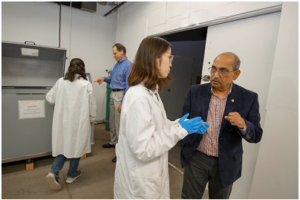WPI professor Adam Powell, postdoctoral fellow Kübra Karayagiz (center) and PhD student Qingli Ding prepare to place welds inside the cyclic corrosion test chamber.
A Worcester Polytechnic Institute (WPI) professor—in collaboration with national laboratories and a global auto parts supplier—is testing a new type of welding that may make the joint between light metal alloys more resistant to corrosion, including salt spray, leading to future designs of durable, next-generation metal car joints used in ultra-light car doors and other vehicle body applications.
Adam Powell, associate professor of mechanical engineering, was awarded a three-year, $1.5 million grant from the Department of Energy’s Office of Energy Efficiency and Renewable Energy’s Vehicle Technologies Office for the research. As the lead institution, WPI is receiving $750,000 while two other groups—Oak Ridge National Laboratory (ORNL) and Pacific Northwest National Laboratory (PNNL)—will split the remainder. Magna International will contribute in-kind time and materials to the project.

The aluminum-magnesium welds are exposed to corrosive conditions inside the test chamber.
Powell said that the auto industry is seeking to reduce the weight of cars and trucks while maintaining the lifespan of a car. One of the ways to do that, he said, is to use advanced lightweight materials such as aluminum and magnesium alloys. The researchers are testing to determine if a new type of welding—known as friction stir welding—reduces corrosion in aluminum-magnesium alloy joints. Currently, any joint involving direct contact between different metals tends to suffer from galvanic corrosion.
“We’re trying to show that corrosion can be much less of a problem with this new type of welding,” said Powell, who is the principal investigator on the project. “We think that this process holds a lot of promise and could make a significant impact on energy use in motor vehicles without reducing the lifespan of a car.”
Under the research plan, Magna, a global mobility technology company and leader in lightweight vehicle structures, provides aluminum and magnesium metals to PNNL, which welds the materials. PNNL then ships the welded parts to WPI, which conducts corrosion and mechanical testing. WPI then sends much of its tested samples to ORNL, which oversees advanced analysis on the welds.
Computer simulations then take place at WPI, said Powell, “to try to understand how the corrosion and mechanical fracture work together.”
“We are trying to show that corrosion can be much less of a problem with this new type of welding,” said Adam Powell, Associate Professor of Mechanical Engineering, WPI.
WPI is currently conducting a series of experiments in a lab using a piece of equipment known as a cyclic corrosion test chamber, which stands about three feet tall and resembles a tanning bed. Powell and his research team place the small sections of welds—which look like tealight candles—in rows inside the chamber. The welds are then exposed to a variety of corrosive environments, including salt spray, high temperatures up to 140 degrees Fahrenheit, and high humidity.
“We expose the welds to a variety of conditions that accelerate the corrosion process simulating the lifecycle of a vehicle,” said Powell. “It’s that cycling between different conditions that leads to accelerated corrosion. WPI’s goal is to use computer simulations that show with a level of confidence that the welds will last for up to 20 years, even in a harsh New England winter.”
Auto companies can then use this simulation capability to do virtual experiments and predict corrosion over the 15- to 20-year lifespan of a car.

Co-principal investigator Brajendra Mishra (right, foreground) confers with PhD student Qingli Ding.
Based on the validated model, the researchers will enable design of low-cost robust welded joints that could be used in ultra-light doors and multiple vehicle body applications.
In the first year of the research, Powell and colleagues will seek to understand corrosion behaviors of magnesium and aluminum diffusion-bonded joints in the test chamber. In the second year, they plan to simulate on a computer both the corrosion of friction stir welded joints and mechanical fracture. In the final year, they expect to make the models much more accurate.
As a result of the research, Powell and his team aim to show that the new welding process will lead to more durable subassemblies made of the two dissimilar metals. Benefits include lighter vehicles, reduced fuel consumption for gas-powered cars, and longer range for electric cars.
“All of these benefits will go a long way to impacting the safety, performance, and lifespan of a car,” said Powell.
In addition to Powell, five WPI researchers are working on the project. They are Brajendra Mishra, a co-principal investigator and head of WPI’s Metal Processing Institute; math professor Marcus Sarkis-Martins and computational scientist Siamak Faal, both of whom will help develop computer simulation models; postdoctoral fellow Kübra Karayagiz; and PhD student Qingli Ding.






